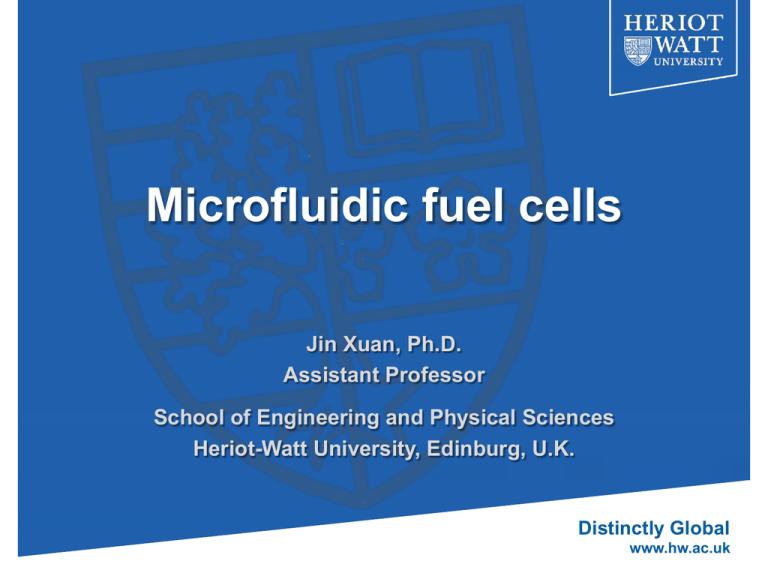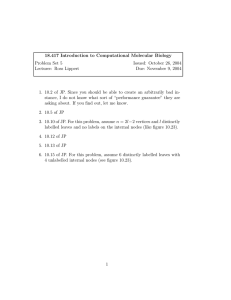Microfluidic fuel cells
advertisement

Microfluidic fuel cells Jin Xuan, Ph.D. Assistant Professor School of Engineering and Physical Sciences Heriot-Watt University, Edinburg, U.K. Distinctly Global www.hw.ac.uk Outline • Introduction • Our research on microfluidic fuel cells – Principle understanding – Modeling – Experiment • Conclusions Distinctly Global www.hw.ac.uk Microfluidics • All flow is laminar • Surface tension becomes significant • Little inertia effects • Apparent viscosity increases • Gradient increases • S/V ratio increases q Application of microfluidics in chemical industry Intensification Picture Source: Bayer microreactors New function Distinctly Global www.hw.ac.uk Fuel cells an important role in low-carbon energy economy v High overall efficiency 45%~60% v.s. 30%~40% for nuclear & thermal systems. v Low environmental impacts Quiet operation; Ultra-low emissions of SOx, NOx and CO2. v Fuel diversity Fuels such as oil, natural gas, alcohols, and biomass-derived fuels are applicable. v Wide-range power supplies Power supplies at different scales from MEMS to a whole city. Energy efficiency comparison by www.fuelcells.org.au Fuel cell power generation is regarded as a 4th generation technology following thermal, nuclear and hydraulic power. Distinctly Global www.hw.ac.uk The membrane Membrane: 40% cost Low catalytic efficiency Membrane: acid preferred High overpotential Membrane: 40% voltage loss Hard in miniaturization MEA structure Reason Bottleneck High cost High cost Water management Fuel crossover Membrane Distinctly Global www.hw.ac.uk Membraneless fuel cells? v Conventional fuel cell Fuel Anode H+ PEM Cathode Oxidant v M E A PEM functions • To separate fuel and oxidant • To maintain a good ionic conductivity M2FC Fuel w How to be membraneless? • Laminar nature of micro flows • Naturally separates the reactant streams • Keeps a good ionic conductivity Oxidant Distinctly Global www.hw.ac.uk Basic cell structure J Power Sources 2013; 231: 1 Distinctly Global www.hw.ac.uk Fluid-fluid interface: the virtual membrane Ø The interface is the key to the success of MFC Ø Investigation techniques developed in our lab: Numerical modeling Fluoresce microscope Laser confocal Distinctly Global www.hw.ac.uk Understanding and controlling the crossover v 2012: Fuel crossover and parasitic current successfully predicted v Developed and Integrated mixed potential theory v 2013: Nonlinear transport characteristics at the interface successfully predicted v Adopting Maxwell–Stefan law Applied Energy 2012; 90: 87 Applied Energy 2013; 112: 1131. Distinctly Global www.hw.ac.uk Focusing the reactants • A qualitative leap: fuel utilization and current density be simultaneously enhanced; • After optimization: I > 100 mA cm-2 with FU > 50%, un-optimized value: FU = 5-8 %. Int J Hydrogen Energy 2011; 36: 11075 Distinctly Global www.hw.ac.uk In-situ visualization of temperature distribution (a) 31 30 29 28 27 26 25 24 H& electrode Anolyte 1000 µμm (b) 0 mA/cm& 20 mA/cm& 40 mA/cm& 60 mA/cm& 80 mA/cm& 100 mA/cm& 0 mA/cm& 20 mA/cm& 40 mA/cm& 60 mA/cm& 80 mA/cm& 100 mA/cm& (c) Catholyte O& electrode (d) 200 µL/min 500 µL/min 800 µL/min 1100 µL/min 1400 µL/min 1700 µL/min 2000 µL/min 2300 µL/min Distinctly Global www.hw.ac.uk Design and prototyping Distinctly Global www.hw.ac.uk Prototypes in our lab (1) Microfluidic fuel cell density by 3 times environmental compatibility v Applications ranging from on-chip power to EVs 0 0 50 J / mA cm-2 100 1.8 0 20 15 Cell voltage / V operation, low cost, good 5 0 E / V vs. Ag/AgCl(satd) Room-temperature MAlAFC in literature 0.6 • Increases the current density by 5 times v 10 1.2 -0.6 Cathode 10 0.6 -1.2 Anode -1.8 0 50 cm-2 J / mA 5 0 100 P / mW cm-2 1.2 • Increases the power P / mW cm-2 New cell architecture 15 Cell voltage / V v 1.8 0 0 60 J / mA cm-2 120 Distinctly Global www.hw.ac.uk Prototypes in our lab (2) An integrated fuel processor & fuel cell system v Simple & cheap fuel cell system integrated with Al-based H2 generator v H2 conversion yield up to 96.2% v Electrochemical performance comparable to the M2FC system fed with compressed H2 in a gas cylinder v The M2FC performed stably until Al was consumed up Prototype of 36188 mAh Distinctly Global 245th ACS MeeNng, New Orleans, 2013 www.hw.ac.uk Prototypes in our lab (3) Microfluidic CO2 reduction cell v v CFD analyses Proof-of-concept prototype CFD analyses of transport and reactions Calculated efficiency D ua l A c id A lk a li 350 250 200 C e ll P ote ntia l (V ) -­‐2 C urre nt de ns ity (m A c m ) 300 150 100 50 0 0.0 0.5 1.0 1.5 2.0 2.5 3.0 D ua l C a thode D ua l A node A c id C a thode A c id A node A lk a li C a thode A lk a li A node 1.6 1.4 1.2 1.0 0.8 0.6 0.4 0.2 0.0 -­‐0.2 -­‐0.4 -­‐0.6 -­‐0.8 -­‐1.0 -­‐1.2 -­‐1.4 -­‐1.6 C e ll pote ntia l (V ) Applied Energy 2013, 102, 1057. 0 50 100 150 200 250 -­‐2 C urre nt de ns ity (m A c m ) 300 Distinctly Global www.hw.ac.uk Scale-out the MFC 16-­‐cell sStack tack prototype Ø Control methods q Pressure redistribution q Local current blocking Ø Significantly reduced scale-out losses Ø Stack efficiency > 90% US Provisional Patent 61886413; Electrochimica Acta, 2014, 135:467 Efficiency over 90% Distinctly Global www.hw.ac.uk Summary • Microfluidic fuel cell is an alternative cell type without the need of a membrane • The L-L interface is the key to the success of MFC. Both model and experiment are conducted to understand and optimize it. • MFC appears to be a promising power source for portable electronic devices. Distinctly Global www.hw.ac.uk Our recent book Micro & Nano-­‐Engineering of Fuel Cells Series: Sustainable Energy Developments Published: July 15, 2014 by CRC Press Editors: D.Y.C. Leung, Jin Xuan hYp://www.crcpress.com/product/isbn/9780415644396 Features q First book focused on the micro and nanoscale engineering science of fuel cells q Comprehensive introduction to general engineering principles applied to various fuel cell types q Both theoretical and practical approach q Contributors are leading experts and researchers in their field Distinctly Global www.hw.ac.uk Thanks very much You are welcome to contact us via Dr. Jin Xuan Email: j.xuan@hw.ac.uk School of Engineering and Physical Sciences Heriot-Watt University, Edinburg, EH14 4AS United Kingdom Distinctly Global www.hw.ac.uk


